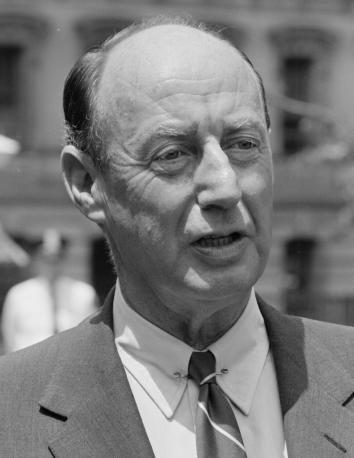There are few modern historical figures I admire more than Adlai E. Stevenson, the thoughtful and self-aware mid-century politician best known today for being a perennial presidential also-ran. Stevenson was the Democratic presidential candidate in 1952 and 1956—he lost both times to Dwight Eisenhower, just in case you fell asleep in your high school history class—and he narrowly missed out on the 1960 nomination when the Democrats instead tapped John F. Kennedy. Stevenson initially refused the 1952 nomination; at the time, he was governor of Illinois. “I just didn’t feel that I had any God-given powers to figure out the solution to coexistence with the Soviet Union and all our other tremendous problems,” he explained later. Stevenson had none of the pathological self-assurance that infects so many other politicians. He was keenly aware of his own flaws and limitations, and openly admitted those limitations in disarming fashion. He was a good writer and a modest man, and he lived in Libertyville, Ill., a 12-minute drive from where I grew up. I like him a lot.
But, until yesterday, I wasn’t aware that Stevenson had a terrible tragedy in his past, something that likely played a part in making him the man he grew up to become. In December 1912, the 12-year-old Stevenson unintentionally shot and killed a 15-year-old cousin-of-a-cousin named Ruth Merwin when a rifle he was handling unexpectedly discharged. As Noel F. Busch tells it in his 1952 biography of Stevenson, Adlai E. Stevenson of Illinois, the future politician’s sister was holding a party when a military-academy student in attendance was urged to perform the military manual of arms. Adlai Stevenson fetched a rifle, which the student examined for safety before performing the drill. Unfortunately, the student wasn’t completely thorough in his examination, and one shell remained in the rifle. A few minutes later, when Stevenson took the gun and attempted to mimic the older boy’s performance, the gun suddenly discharged. Here’s Busch:
The bullet entered Ruth Merwin’s forehead. She fell dead, on the carpet in the hall. The elder Stevensons returned a few minutes later.
“What boy did this?” Lewis Stevenson asked.
“I did,” said Adlai. Then he went up to his room and lay down on the bed.
At an inquest the next day, he was cleared of all blame for the accident. The account of the inquest published in the Pantagraph mentioned that “Adlai Stevenson, prostrated with grief, was unable to be present.”
That’s the official story. But in his thorough 1976 biography, Adlai Stevenson of Illinois, John Bartlow Martin tells a different tale. An anonymous eyewitness whom Martin interviewed claims that “Adlai took the gun from the other boy, pointed it at one of the girls, Ruth Merwin, and pulled the trigger.” This, honestly, sounds more believable than the other story, and more in line with what we know about how unintentional child shooting deaths generally happen. Guns do not often discharge on their own, even old and rusty guns. But it’s entirely plausible that a 12-year-old boy, equally intrigued by guns and girls, might pick up a gun and point it at a girl, hoping to throw a scare into her. It’s just as plausible that, hoping to avoid further tragedy, the family might close ranks and insist that the gun accidentally discharged.
If this had happened in 2012 instead of 1912, I would almost certainly be writing about how Stevenson’s parents ought to face criminal charges over Merwin’s death, for neglecting basic gun-safety protocols like “don’t leave a loaded rifle unsecured in the attic.” But you can’t realistically apply modern standards to the early-20th-century world. We do know that, for years thereafter, guns were barred from the Stevenson home. And for the rest of his life, Stevenson remained silent about the incident—not even mentioning it to his wife—until a Time reporter broached the subject during an interview in 1952.
But that doesn’t mean he wasn’t affected by it. Most of Stevenson’s biographers have speculated on the effect the shooting may have had on Stevenson’s life. In his 1966 book Adlai Stevenson: Citizen of the World, Bill Severn notes that some of Stevenson’s friends “thought his whole character was changed by it, his feelings deepened and strengthened in a desire to always do what was right.” John Bartlow Martin suggests that Stevenson’s residual guilt over the incident “may explain his self-doubts and his protestations of unworthiness,” as well as his lifelong habit of “turning triumphs into disasters, honors into burdens, as unconscious penance for his deed.” At the very least, we can say that Stevenson carried the memory of Ruth Merwin with him until he died. In 1955, Stevenson wrote a letter to a woman he had never met, whose son had unintentionally killed another child. His advice was heartfelt and brief: “Tell him that he must live for two.”
Previous coverage of child shootings:
A Guide for Reporters: How to Write about Unintentional Child Shootings
A New Study Shows Why It’s So Important to Reduce Child Gunshot Injuries
Gun Safety Laws Are Pointless If Nobody Bothers to Enforce Them
There Are Way More Unintentional Child Shootings Than Anyone Thought
California’s Strict New Access Prevention Law Won’t Do Much to Stop Child Shooting Deaths
Trigger Locks, the Dubiously Effective Safety Measure that Gun Control Advocates Love
Another “Accidental” Shooting. Another Child Dead. Another State Claims, Wrongly, That No One Is at Fault.
Is It Ever Really an Accident When a 4-Year-Old Shoots and Kills His Father?
